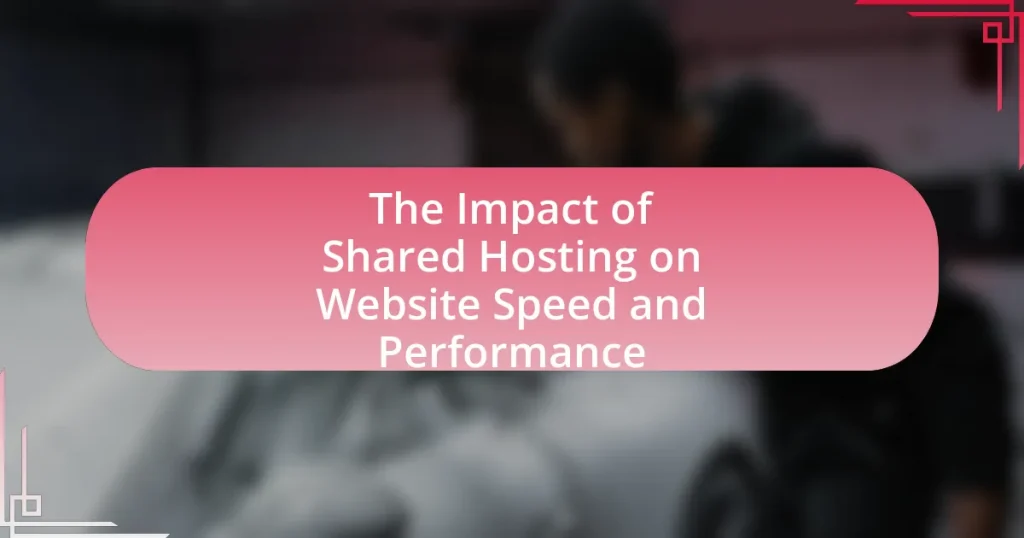Shared hosting significantly impacts website speed and performance due to the allocation of limited server resources among multiple users. This environment can lead to slower loading times, particularly during peak traffic periods, with studies indicating that websites on shared hosting may load up to 50% slower than those on dedicated servers. Key factors influencing performance include server resource limitations, the number of websites sharing the server, server location, and the quality of the hosting provider. Additionally, website speed is crucial for user experience and SEO rankings, as slow performance can result in increased bounce rates and reduced conversion rates. Understanding these dynamics is essential for website owners to optimize their shared hosting environments effectively.

What is the Impact of Shared Hosting on Website Speed and Performance?
Shared hosting negatively impacts website speed and performance due to resource limitations. In shared hosting environments, multiple websites share the same server resources, including CPU, RAM, and bandwidth. This can lead to slower loading times, especially during peak traffic periods when resources are stretched thin. A study by HostingAdvice found that websites on shared hosting can experience loading times that are 50% slower compared to those on dedicated servers. Additionally, the performance can be further affected by the activities of other websites on the same server, as high traffic or resource-intensive processes from one site can slow down others.
How does shared hosting influence website speed?
Shared hosting significantly influences website speed by allocating limited server resources among multiple users. In shared hosting environments, numerous websites share the same server, which can lead to slower loading times, especially during peak traffic periods. Research indicates that websites on shared hosting can experience latency increases of up to 50% compared to those on dedicated servers, primarily due to resource contention. This resource sharing can result in slower response times and reduced performance, particularly if one or more sites on the server consume excessive bandwidth or processing power.
What factors in shared hosting affect loading times?
The factors in shared hosting that affect loading times include server resources, the number of websites on the server, server location, and the quality of the hosting provider. Server resources, such as CPU, RAM, and bandwidth, directly influence how quickly a website can process requests; limited resources can lead to slower loading times. The number of websites sharing the same server can cause resource contention, resulting in increased loading times during peak traffic. Server location affects latency; a server located far from the user can increase loading times due to longer data travel distances. Lastly, the quality of the hosting provider, including their infrastructure and support, can significantly impact performance; providers with outdated technology or poor management may lead to slower loading times.
How does server resource allocation impact performance?
Server resource allocation directly impacts performance by determining the amount of CPU, memory, and bandwidth available to applications and websites. When resources are allocated efficiently, applications can run smoothly, leading to faster load times and improved user experience. Conversely, inadequate resource allocation can result in slow response times, increased latency, and potential downtime, negatively affecting overall performance. For instance, a study by Google found that a one-second delay in page load time can lead to a 20% decrease in conversion rates, highlighting the critical role of proper resource allocation in maintaining optimal performance.
Why is website performance critical for user experience?
Website performance is critical for user experience because it directly influences user satisfaction and engagement. Fast-loading websites reduce bounce rates, as studies show that 47% of users expect a page to load in two seconds or less. Additionally, improved performance enhances user retention; a one-second delay in page response can result in a 7% reduction in conversions, according to research by Akamai. Therefore, optimal website performance is essential for maintaining user interest and driving business success.
What are the consequences of slow website performance?
Slow website performance leads to increased bounce rates, reduced user satisfaction, and lower conversion rates. Research indicates that a one-second delay in page load time can result in a 7% reduction in conversions, as found in a study by Akamai. Additionally, Google reports that 53% of mobile users abandon sites that take longer than three seconds to load. These statistics highlight the direct negative impact of slow performance on user engagement and business outcomes.
How does website speed affect SEO rankings?
Website speed significantly affects SEO rankings, as search engines prioritize fast-loading sites in their algorithms. Google has confirmed that page speed is a ranking factor, stating that faster websites provide a better user experience, leading to lower bounce rates and higher engagement. According to a study by Google, a delay of just one second in page load time can result in a 20% decrease in conversion rates. Therefore, optimizing website speed is crucial for improving SEO performance and achieving higher visibility in search engine results.
What are the common misconceptions about shared hosting?
Common misconceptions about shared hosting include the belief that it is inherently slow, insecure, and unsuitable for professional websites. In reality, shared hosting can provide adequate speed and performance for many small to medium-sized websites, as providers often implement optimizations and resource management techniques. Additionally, while security concerns exist due to shared resources, reputable hosting companies employ robust security measures, such as firewalls and regular updates, to protect all users. Furthermore, many successful businesses operate on shared hosting plans, demonstrating that it can be a viable option for professional use when chosen wisely.
Is shared hosting always slower than dedicated hosting?
Shared hosting is not always slower than dedicated hosting. While dedicated hosting typically offers better performance due to exclusive resources, shared hosting can perform adequately for low-traffic websites or applications. Factors such as server configuration, resource allocation, and the specific hosting provider can influence speed. For instance, a well-optimized shared hosting environment may deliver comparable speeds to a poorly configured dedicated server. Therefore, the performance of shared hosting can vary significantly based on these conditions.
Can shared hosting be optimized for better performance?
Yes, shared hosting can be optimized for better performance. Techniques such as utilizing content delivery networks (CDNs), optimizing images, and implementing caching mechanisms can significantly enhance loading speeds. For instance, a study by Google found that reducing page load time by just a few seconds can lead to increased user engagement and higher conversion rates. Additionally, configuring server settings and minimizing the use of heavy plugins can further improve performance in a shared hosting environment.

What are the specific performance metrics affected by shared hosting?
Shared hosting specifically affects performance metrics such as website loading speed, uptime reliability, server response time, and resource allocation. In shared hosting environments, multiple websites share the same server resources, which can lead to slower loading speeds due to increased traffic and limited bandwidth. Uptime reliability may also be compromised, as server overloads can result in downtime. Server response time is often negatively impacted because the server must handle requests from multiple users simultaneously. Additionally, resource allocation is limited, meaning that websites may experience throttling during peak usage times, further degrading performance. These metrics are critical for assessing the overall speed and performance of websites hosted on shared servers.
How do load times vary across different shared hosting providers?
Load times significantly vary across different shared hosting providers due to factors such as server resources, data center locations, and the number of users sharing the same server. For instance, providers like Bluehost and SiteGround typically offer faster load times, averaging around 2-3 seconds, due to optimized server configurations and better resource allocation. In contrast, less reputable providers may experience load times exceeding 5 seconds, negatively impacting user experience and SEO rankings. Research indicates that a one-second delay in load time can lead to a 7% reduction in conversions, highlighting the importance of choosing a reliable hosting provider for optimal website performance.
What benchmarks should be used to measure website speed?
To measure website speed, key benchmarks include Time to First Byte (TTFB), First Contentful Paint (FCP), and Fully Loaded Time. TTFB measures the time taken for the server to respond to a request, indicating server performance; studies show that a TTFB under 200 milliseconds is optimal for user experience. FCP tracks the time it takes for the first piece of content to appear on the screen, with a target of under 1 second for better engagement. Fully Loaded Time measures how long it takes for all elements of a page to load, with a benchmark of under 3 seconds being ideal to minimize bounce rates. These benchmarks provide a comprehensive view of website speed and performance, particularly in the context of shared hosting environments.
How can users assess the performance of their shared hosting service?
Users can assess the performance of their shared hosting service by monitoring key metrics such as uptime, load time, and server response time. Uptime refers to the percentage of time the server is operational, with a reliable service typically achieving 99.9% uptime. Load time measures how quickly a website loads, ideally under three seconds, as studies show that a delay of just one second can reduce conversions by 7%. Server response time indicates how quickly the server processes requests, with optimal response times being under 200 milliseconds. Tools like Pingdom, GTmetrix, and Google PageSpeed Insights can provide detailed insights into these metrics, allowing users to evaluate their hosting service’s performance effectively.
What role does server location play in website speed?
Server location significantly affects website speed by determining the physical distance between the server and the user. When a user requests a webpage, data must travel from the server to the user’s device; shorter distances result in faster data transmission. For instance, a study by Akamai found that a 100-millisecond delay in server response time can reduce conversion rates by 7%. Therefore, hosting a website on a server closer to the target audience can enhance loading times and improve overall user experience.
How does proximity to the server impact loading times?
Proximity to the server significantly impacts loading times, as shorter distances reduce latency. When a user accesses a website, data travels through various network paths to reach the user’s device; the closer the server is to the user, the fewer hops and less time it takes for the data to arrive. Studies indicate that latency increases by approximately 20 milliseconds for every 1000 kilometers between the server and the user, demonstrating that geographical distance directly correlates with loading speed. Therefore, hosting a website on a server located near the target audience can enhance performance and user experience.
What are the implications of using a global CDN with shared hosting?
Using a global CDN with shared hosting can significantly enhance website speed and performance by distributing content across multiple servers worldwide. This distribution reduces latency, as users access data from the nearest server, leading to faster load times. Additionally, a CDN can alleviate bandwidth strain on shared hosting servers, improving overall site reliability and performance during traffic spikes. Studies show that websites utilizing CDNs can experience load time improvements of up to 50%, which is crucial for user retention and SEO rankings.
How do traffic spikes affect shared hosting performance?
Traffic spikes negatively affect shared hosting performance by overwhelming the limited resources allocated to each user. In shared hosting environments, multiple websites share the same server resources, such as CPU, RAM, and bandwidth. When a sudden increase in traffic occurs, the demand for these resources can exceed their availability, leading to slower load times, increased latency, and potential downtime for websites. Studies have shown that websites on shared hosting can experience a performance degradation of up to 50% during peak traffic periods, as the server struggles to manage the competing demands of multiple sites.
What strategies can mitigate performance issues during high traffic?
To mitigate performance issues during high traffic, implementing load balancing is essential. Load balancing distributes incoming traffic across multiple servers, preventing any single server from becoming overwhelmed. According to a study by NGINX, using load balancing can improve application availability by up to 99.99%, ensuring that user requests are handled efficiently even during peak times. Additionally, utilizing content delivery networks (CDNs) can significantly reduce latency by caching content closer to users, which is supported by research from Akamai showing that CDNs can enhance website load times by 50% or more. Finally, optimizing database queries and employing caching mechanisms can further enhance performance, as evidenced by a report from Google indicating that reducing server response times can lead to a 20% increase in user engagement.
How does resource sharing among users impact individual site performance?
Resource sharing among users negatively impacts individual site performance by leading to resource contention. In shared hosting environments, multiple websites utilize the same server resources, such as CPU, memory, and bandwidth. When one site experiences high traffic or resource usage, it can slow down or disrupt the performance of other sites on the same server. Studies indicate that websites on shared hosting can experience latency increases of up to 50% during peak usage times due to this contention. This degradation in performance can result in slower load times, reduced user satisfaction, and potentially lower search engine rankings.

What best practices can enhance website speed on shared hosting?
To enhance website speed on shared hosting, optimizing images is essential. Compressed images reduce file size without sacrificing quality, leading to faster load times. Tools like TinyPNG or ImageOptim can effectively decrease image sizes, improving overall site performance. Additionally, leveraging browser caching allows frequently accessed resources to be stored locally on users’ devices, which decreases load times for returning visitors. Implementing a Content Delivery Network (CDN) can also significantly enhance speed by distributing content across multiple servers globally, reducing latency. Furthermore, minimizing HTTP requests by combining CSS and JavaScript files streamlines the loading process. These practices collectively contribute to improved website speed on shared hosting environments.
How can website owners optimize their content for speed?
Website owners can optimize their content for speed by minimizing file sizes, leveraging browser caching, and utilizing Content Delivery Networks (CDNs). Reducing file sizes can be achieved through image compression and minifying CSS and JavaScript files, which decreases load times. Browser caching allows frequently accessed resources to be stored locally, reducing the need for repeated downloads. CDNs distribute content across multiple servers globally, ensuring faster delivery to users based on their geographic location. According to Google, optimizing images can lead to a 50-80% reduction in file size, significantly improving loading speed.
What are the best practices for image optimization?
The best practices for image optimization include using appropriate file formats, compressing images, and implementing responsive design. Using formats like JPEG for photographs and PNG for graphics ensures quality while minimizing file size. Compression tools can reduce image size without significantly affecting visual quality; for instance, tools like TinyPNG can decrease file size by up to 70%. Additionally, responsive design techniques, such as using CSS to adjust image sizes based on screen resolution, enhance loading times and improve user experience. These practices collectively contribute to faster website loading speeds, which is crucial for performance, especially in shared hosting environments where resources are limited.
How can caching improve website performance?
Caching can significantly improve website performance by storing frequently accessed data, which reduces the time needed to retrieve information from the server. When a user requests a webpage, caching allows the server to deliver stored content quickly instead of generating it anew, leading to faster load times. For instance, studies show that implementing caching can reduce server response times by up to 80%, enhancing user experience and decreasing bounce rates. Additionally, caching minimizes server load, allowing shared hosting environments to handle more simultaneous users efficiently, which is crucial for maintaining performance in high-traffic situations.
What tools are available to monitor website speed and performance?
Tools available to monitor website speed and performance include Google PageSpeed Insights, GTmetrix, Pingdom, and WebPageTest. Google PageSpeed Insights analyzes the content of a web page and provides suggestions to make that page faster, while GTmetrix combines Google Lighthouse and WebPageTest to give detailed performance reports. Pingdom offers real-time monitoring and alerts for website uptime and performance, and WebPageTest allows users to run performance tests from multiple locations globally, providing in-depth metrics. These tools are widely recognized in the industry for their accuracy and reliability in assessing website performance.
Which performance testing tools provide the best insights?
Performance testing tools that provide the best insights include Apache JMeter, LoadRunner, and Gatling. Apache JMeter is widely recognized for its ability to simulate heavy loads and analyze performance metrics, making it a preferred choice for web applications. LoadRunner offers comprehensive testing capabilities and detailed reporting features, allowing users to identify bottlenecks effectively. Gatling is known for its high performance and real-time monitoring, providing developers with actionable insights during testing. These tools are validated by their widespread use in the industry and positive user feedback regarding their effectiveness in delivering critical performance insights.
How can website owners use analytics to improve speed?
Website owners can use analytics to improve speed by monitoring key performance metrics such as page load time, bounce rate, and user engagement. By analyzing these metrics, website owners can identify slow-loading pages and specific elements that contribute to delays, allowing them to optimize images, reduce server response times, and streamline code. For instance, Google Analytics provides insights into user behavior and site performance, enabling owners to pinpoint areas needing improvement. Studies show that a one-second delay in page load time can lead to a 7% reduction in conversions, highlighting the importance of speed optimization based on analytical data.
What are the common troubleshooting steps for slow websites on shared hosting?
To troubleshoot slow websites on shared hosting, first, check server resource usage, as shared hosting limits CPU and RAM, which can lead to slow performance. Next, optimize website content by compressing images and minifying CSS and JavaScript files to reduce load times. Additionally, review installed plugins and remove any unnecessary ones, as excessive plugins can slow down the site. Implement caching solutions to store static versions of pages, which can significantly improve loading speed. Finally, consider upgrading to a higher-tier hosting plan if resource limits are consistently reached, as this can provide better performance. These steps are validated by numerous web performance studies indicating that resource management and optimization directly impact website speed.
How can users identify the root cause of performance issues?
Users can identify the root cause of performance issues by systematically analyzing various factors affecting their website. This involves monitoring server response times, checking resource usage, and evaluating website code for inefficiencies. Tools such as Google PageSpeed Insights and GTmetrix provide insights into loading times and suggest optimizations. Additionally, reviewing server logs can reveal patterns of high traffic or errors that contribute to slow performance. By correlating these data points, users can pinpoint specific issues, such as inadequate server resources or poorly optimized content, leading to informed decisions for improvement.
What actions can be taken to resolve common speed problems?
To resolve common speed problems in shared hosting environments, website owners can optimize their content delivery by utilizing a Content Delivery Network (CDN). A CDN reduces latency by distributing content across multiple servers globally, ensuring faster access for users regardless of their location. Additionally, compressing images and files can significantly decrease load times, as smaller file sizes require less bandwidth and processing power. Implementing caching mechanisms, such as browser caching and server-side caching, can also enhance speed by storing frequently accessed data for quicker retrieval. According to a study by Google, optimizing images can lead to a 50% reduction in load times, demonstrating the effectiveness of these actions in improving website performance.















